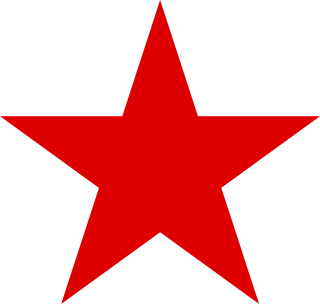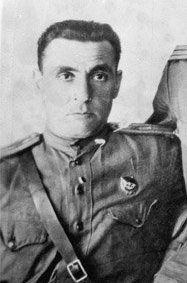The 270th Rifle Division was a Red Army infantry division formed twice during World War II, in 1941 and 1942.
The 87th Rifle Division was an infantry division of the Red Army, active before, during the Second World War and afterwards.

Movlid Visaitov was a Chechen Red Army colonel and a Hero of the Soviet Union. Visaitov was commander of 255th Separate Chechen–Ingush cavalry regiment during World War II.
The 181th Rifle Division was an infantry division of the Soviet Red Army during World War II that was active from 1940-1945.
The 300th Rifle Division began service as a standard Red Army rifle division shortly after the German invasion, and fought in the southwestern part of the Soviet-German front for nearly two years following. It was able to escape the encirclement east of Kiev in September, 1941, and then fought to defend, and later to try to liberate, the city of Kharkov during 1941-42. After falling back under the weight of the German 1942 summer offensive, the division began distinguish itself during Operation Uranus in late 1942, when it helped defeat the German attempt to relieve Sixth Army and later in the pursuit of the defeated Axis forces and the second liberation of Rostov-na-Donu. In recognition of these successes it was raised to Guards status as the 87th Guards Rifle Division. A second 300th Rifle Division was raised a few months later and fought briefly but very successfully against the Japanese in Manchuria in August 1945. The second formation became the 3rd Tank Division in the Far East postwar and was redesignated as the 46th Tank Division in 1957 before disbanding in 1959.
The 114th Rifle Division began service in July 1939 as a standard Red Army rifle division, as part of the pre-war expansion of the Soviet forces. It was stationed on the Svir River front in the autumn of 1941 and had a relatively uneventful war facing the Finns until the Vyborg–Petrozavodsk Offensive began on June 10, 1944, from which point it saw much more active service. As the Finns were leaving the war the division was transferred to 14th Army in the Arctic, from where it helped to defeat and pursue the German forces from Lapland into Norway.
The 408th Rifle Division was formed as an infantry division of the Red Army, and served in that role #in 1941-42. It was officially considered an Armenian National division, but in fact was made up of several other nationalities as well. After forming it remained in service in the Caucasus and Iran until the summer of 1942, when it was redeployed to help counter the German drive toward Tuapse. The 408th had a short and undistinguished career as a combat formation, and was soon disbanded.
The 81st Cavalry Division was a mounted division of the Red Army that served in the first years of the Great Patriotic War. It was formed in the autumn of 1941 and served in the region south of Stalingrad while the German Army besieged that city in the autumn of 1942. During the first stages of the Soviet counteroffensive, Operation Uranus, the 81st was given a prominent role in the exploitation to the southwest, but became overextended and vulnerable to the mobile German reinforcements arriving to attempt a breakthrough to their 6th Army. The division was badly mauled in the opening stages of Operation Winter Storm, but continued to serve in Southern Front's advance on Rostov and on into the Donbass. It was finally disbanded in May, 1943.

The 10th Air Army was a unit of the Soviet Air Forces during World War II and the Cold War years.

The 97th Cavalry Division was a cavalry division of the Red Army that served in the first years of the Great Patriotic War, but did not see any combat. It began forming in November, 1941, in the Central Asia Military District as a "Turkmen National Division". Three other cavalry divisions, the 61st, 63rd and the 81st were formed in this district at about the same time, also from men of Central Asian nationalities, and while those divisions became the latest complement of the 3rd Formation of the 4th Cavalry Corps in November, the 97th did not join that Corps until over a year later.

The 61st Cavalry Division was a cavalry division of the Red Army that served in the first years of the Great Patriotic War. It was formed in September – October, 1941, and saw its first actions to the south of Stalingrad during the German siege of that city in the autumn of 1942. When the Soviet counteroffensive, Operation Uranus, began in November the 61st formed a significant part of the mobile forces of its 51st Army. After the positions of Romanian 4th Army were broken through the division took part in the exploitation to the southwest, but became overextended and vulnerable to the mobile German reinforcements arriving to attempt a breakthrough to their Sixth Army. The 61st suffered such severe losses that it had to be withdrawn to the reserves in December, and was later disbanded.

Khavazi Muhamed-Mirzaev was a Chechen cavalry soldier during World War II who was posthumously awarded the title Hero of the Soviet Union on 15 January 1944.

Yaponts Arskievich Abadiyev was a Soviet cavalry regiment commander during the Second World War. At the start of the war he was positioned as the deputy commander of a tank regiment, but was soon assigned as the commander of the 126th Cavalry Regiment. He briefly served as commander of the 255th Separate Chechen-Ingush Cavalry Regiment, but soon accepted command of a regiment within the 115th Kabardian-Balkar Cavalry Division. During the war he was injured multiple times, as his division was ordered to confront the 4th Panzer Army despite their cavalrymen being no match for the tanks. Despite his long service in the Red Army, his entire family was deported in the Aardakh, and was sent to Bashkortostan to command a reserve regiment. After the war he was stationed in a variety of cities, but did not get to return to his homeland of Ingushetia until the 1980s.

The 402nd Rifle Division was raised in 1941 as an infantry division of the Red Army, and served throughout the Second World War in that role. It was raised as an Azerbaijani National division in the Transcaucasus Military District and first formed part of the occupation force following the Anglo-Soviet invasion of Iran. It returned to the USSR in April, 1942, remaining in the Caucasus region until the forces of German Army Group A began its drive on the oil fields there as part of Operation Blue. In October it joined the Northern Group in the Transcaucasus Front, in the 44th Army, defending the direct route to Baku. The division took part in the counteroffensive that threw the German forces out of the Caucasus, but took heavy losses in the process. Once the German threat receded the 402nd returned to guard duties along the border with Turkey and served as a training establishment for Azeri recruits for the duration of the war.
The 406th Rifle Division was raised in 1941 as an infantry division of the Red Army, and served throughout the Second World War in that role, but saw relatively little combat. It was raised as a Georgian National division in the Transcaucasus Military District, where it remained until the forces of German Army Group A began its drive on the oil fields there as part of Operation Blue. In August 1942 it joined the Northern Group in the Transcaucasus Front, in the 46th Army, defending the high passes through the High Caucasus Mountains west of Mount Elbrus. Once the German threat receded, the 406th returned to guard duties along the borders with Turkey and Iran for the duration of the war.
The 414th Rifle Division was twice formed as an infantry division of the Red Army; very briefly in the winter of 1941/42, then from the spring of 1942 until after May 1945. It was officially considered a Georgian National division, having nearly all its personnel of that nationality in its second formation. After its second formation it remained in service in the Caucasus near the borders of Turkey and Iran in the 44th Army until the summer of 1942, when it was redeployed to help counter the German drive toward Grozny. As German Army Group A retreated from the Caucasus in January 1943 the division was reassigned to the 37th Army in North Caucasus Front, and during the fighting in the Taman Peninsula during the summer it served in both the 58th and 18th Armies, earning a battle honor in the process. It entered the Crimea during the Kerch–Eltigen Operation in November, and was awarded the Order of the Red Banner following the offensive that liberated that region in April and May 1944, fighting in the 11th Guards Rifle Corps of the Separate Coastal Army. After the Crimea was cleared the Coastal Army remained as a garrison and the 414th stayed there for the duration of the war. Postwar, it was relocated to Tbilisi, being renumbered as the 74th Rifle Division in 1955 and disbanded the following year.
The 421st Rifle Division was raised in 1941 as an infantry division of the Red Army, and served briefly after the German invasion, Operation Barbarossa, in that role. The division was formed from assets of the Odessa Military District after its namesake city came under siege by a mainly-Romanian force, and it immediately became part of the Separate Coastal Army. It was one of several improvised Soviet formations that saw service in this fighting, and its order of battle changed considerably over the course of its short existence. Prior to the fall of Odessa on October 16 what remained of the division was evacuated to the Crimea. On November 13 it was disbanded to provide replacement troops and equipment for other units defending the fortress of Sevastopol. The 421st was never reformed.
The 209th Rifle Division was formed as an infantry division of the Red Army after a motorized division of that same number was destroyed in the first weeks of the German invasion of the Soviet Union. It served through nearly the remainder of the war on a quiet sector in Transbaikal Front, mostly as part of 36th Army. During July 1945, in the leadup to the Soviet invasion of Manchuria, it was transferred to 17th Army, still in Transbaikal Front. This Army was in the second echelon of the invading forces and saw very little, if any, actual combat, but the division was nevertheless given a battle honor. It had been disbanded by mid-1946.
The 51st Air Defense Division, abbreviated 51 dpvo, is an air defense formation of the 4th Air and Air Defence Forces Army of the Russian Aerospace Forces, which in turn is operationally subordinate to the Southern Military District. The headquarters is located in Novocherkassk.
The 255th Rifle Division was formed in the Odessa Military District as a reserve infantry division of the Red Army about two weeks after the German invasion of the USSR. It was based on the shtat of April 5, 1941 with modifications due to the emergency. Once formed, in late August it was assigned to the 2nd formation of the 6th Army in Southern Front; this Army was soon reassigned to Southwestern Front. The division saw its first major combat in the Barvenkovo–Lozovaya offensive in January 1942 which carved out the Izium salient, but it suffered significant losses which were never adequately replaced. Due to its low strength it was removed from the salient and served as a reserve formation until the beginning of the German summer offensive. In the second week of July, while serving in 9th Army, it was largely encircled by elements of German 6th Army near Millerovo. While a cadre was able to escape and retreat south toward the Caucasus the division was too badly damaged to be rebuilt and it was disbanded.






